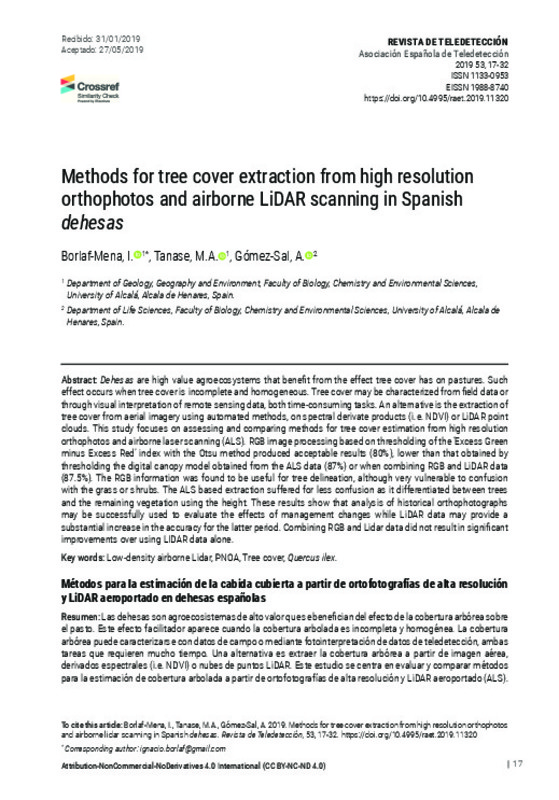JavaScript is disabled for your browser. Some features of this site may not work without it.
Buscar en RiuNet
Listar
Mi cuenta
Estadísticas
Ayuda RiuNet
Admin. UPV
Desde el lunes 3 y hasta el jueves 20 de marzo, RiuNet funcionará en modo de solo lectura a causa de su actualización a una nueva versión.
Métodos para la estimación de la cabida cubierta a partir de ortofotografías de alta resolución y LiDAR aeroportado en dehesas españolas
Mostrar el registro completo del ítem
Borlaf-Mena, I.; Tanase, MA.; Gómez-Sal, A. (2019). Métodos para la estimación de la cabida cubierta a partir de ortofotografías de alta resolución y LiDAR aeroportado en dehesas españolas. Revista de Teledetección. (53):17-32. https://doi.org/10.4995/raet.2019.11320
Por favor, use este identificador para citar o enlazar este ítem: http://hdl.handle.net/10251/122781
Ficheros en el ítem
Metadatos del ítem
| Título: | Métodos para la estimación de la cabida cubierta a partir de ortofotografías de alta resolución y LiDAR aeroportado en dehesas españolas | |
| Otro titulo: |
|
|
| Autor: | Borlaf-Mena, I. Tanase, M. A. Gómez-Sal, A. | |
| Fecha difusión: |
|
|
| Resumen: |
[EN] Dehesas are high value agroecosystems that benefit from the effect tree cover has on pastures. Such effect occurs when tree cover is incomplete and homogeneous. Tree cover may be characterized from field data or through ...[+]
[ES] Las dehesas son agroecosistemas de alto valor que se benefician del efecto de la cobertura arbórea sobre el pasto. Este efecto facilitador aparece cuando la cobertura arbolada es incompleta y homogénea. La cobertura ...[+]
|
|
| Palabras clave: |
|
|
| Derechos de uso: | Reconocimiento - No comercial - Sin obra derivada (by-nc-nd) | |
| Fuente: |
|
|
| DOI: |
|
|
| Editorial: |
|
|
| Versión del editor: | https://doi.org/10.4995/raet.2019.11320 | |
| Código del Proyecto: |
|
|
| Agradecimientos: |
IGN and the Andalusian government are acknowledged for providing the airborne datasets. The study was carried out under the projects LIFE+ bioDehesa (LIFE11/BIO/ES/000726) and FUNDIVER (MINECO, Spain; CGL2015-69186-C2-2-R ...[+]
|
|
| Tipo: |
|








